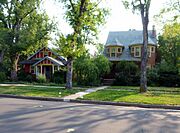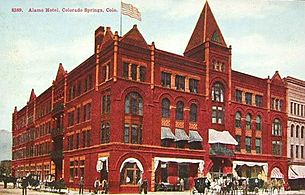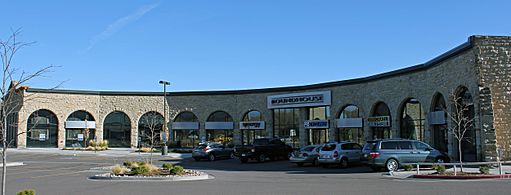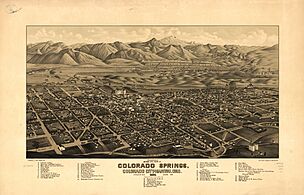History of Colorado Springs, Colorado facts for kids
Quick facts for kids
History of Colorado Springs, Colorado
|
|
|---|---|

The 1903-1973 El Paso County Courthouse (now the Colorado Springs Pioneers Museum).
|
|
| Country | United States |
| State | Colorado |
| County | El Paso |
| Municipality | City of Colorado Springs |
| Population history |
|
Before it was founded, the area where Colorado Springs is today was a wild, undeveloped part of the American frontier. In 1859, during the Pike's Peak Gold Rush, a town called Old Colorado City was built. It even became the capital of the Colorado Territory for a short time.
General William Jackson Palmer founded Colorado Springs in 1871 as a special resort town. Later, Old Colorado City became part of Colorado Springs. Railroads brought many visitors and tourists to the area from all over the United States and other countries. The city became known as a hub for seven different railways.
Colorado Springs was also important during the Cripple Creek Gold Rush. It had many places where people could trade and sell mining shares. Important people like Palmer, Spencer Penrose, and Winfield Scott Stratton gave land and money to create parks, buildings, and non-profit groups.
The city became a home for successful mine owners, artists, and writers. Its dry climate and beautiful mountain setting made it a popular place for tourists and a health resort. Many people with lung problems, like tuberculosis, came here for treatment.
Later, Colorado Springs became very important for the military. It supported three major military bases during World War II and the Cold War. The North American Aerospace Defense Command (NORAD) center was first located in the city before it moved inside Cheyenne Mountain.
Contents
Amazing Landforms of Colorado Springs

The land around Colorado Springs has some amazing natural features. For example, Cheyenne Mountain in the southwest was formed from very old rock called Pikes Peak granite. This rock was pushed up when the Ancestral Rocky Mountains formed.
The city's hills, like the Mesa and Knob Hill, created valleys for different creeks such as Camp, Cheyenne, and Fountain creeks. Monument Creek flows from the north.
Colorado Springs is famous for its mineral springs. These springs flow from underground water sources. Some well-known springs included Horn's Mineral Springs and Monument Springs in Monument Valley Park. There were also other springs on various streets in the city.
Before the City Was Built
Native American History
The Ute people have always believed the Pikes Peak area is their homeland. They call Pikes Peak "Tavakiev," which means Sun Mountain. The Utes were hunter-gatherers, meaning they hunted animals and gathered plants for food.
In the summer, they lived in the mountains. In the fall, they would travel down Ute Pass to visit the springs. They believed these springs had spirits and would make offerings for good health and hunting. Then, they would travel east to hunt buffalo. In winter, they stayed in mountain valleys to be safe from the cold weather.
Ancient tools like grinding stones, found in the Garden of the Gods, show that Native American groups used to gather there. These tools suggest they processed animal hides and meat after their hunts.
Other tribes, like the Arapaho and Cheyenne, also gathered in the Manitou Springs and Garden of the Gods areas. Cheyenne Mountain was important to the Cheyenne people because it provided wood for their teepee poles. Waterfalls were seen as spiritual places where people could find inspiration.
By 1882, the Utes were forced to move to special lands called reservations in southwestern Colorado and eastern Utah.
Early Explorers and Treaties
The land of Colorado Springs was once part of New France and New Spain due to old treaties. In 1803, it became part of the United States through the Louisiana Purchase. After this, explorers began to enter the area.
Zebulon Pike explored the region in November 1806. The land was later part of the Kansas Territory in 1854. In 1857, a group of soldiers camped near Jimmy Camp Creek. Other explorers like Juan Bautista de Anza and Stephen Harriman Long also passed near the area.
Founding of Colorado Springs
Gold Rush and Early Settlements
Colorado City, now known as Old Colorado City, was founded on August 13, 1859. It was the first settlement in the Pikes Peak region. For a short time, from 1861 to 1862, Colorado City was even the capital of the Colorado Territory. The capital later moved to Golden and then to Denver.
Several important roads led into the area. One was a toll road that connected to the "Despatch Express Route." Another was the Old Stage Road, which went through Cheyenne Creek's canyon to Cripple Creek. The Cherokee Trail and Jimmy Camp Trail were also important routes. The Jimmy Camp Trail was part of the Trapper's Trail, used by trappers and explorers since the 1820s.
How Colorado Springs Was Created
Civil War General William Jackson Palmer came to Colorado as a surveyor for the Kansas Pacific Railway. He was looking for good places to build railroad lines. Dr. William Abraham Bell from England was also with him.
In July 1869, Palmer and Bell saw the beautiful valley near Pikes Peak and thought it would be a perfect place for a town. They founded "Fountain Colony" on July 31, 1871. The town was officially named Colorado Springs by 1879. It was named after the springs found along Monument Creek.
In 1873, Colorado Springs became the main town for El Paso County, taking over from Colorado City. Early on, the town built 60 miles of irrigation canals and got drinking water from Ruxton Creek.
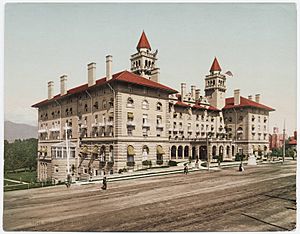
Colorado Springs was sometimes called "Little London" because many English tourists and settlers came to live there. Dr. William Abraham Bell and Palmer's English business partners helped bring people and money to the town. The Denver and Rio Grande Railroad started serving the city in October 1871.
The Pikes Peak region was a very popular travel spot in the late 1800s. Many writers, artists, and people from England moved to Colorado Springs. Popular attractions included the Garden of the Gods, Glen Eyrie, Pikes Peak, and Cheyenne Canyon.
People from all over the world were drawn to the city's high altitude, sunshine, mineral waters, and dry climate. It was seen as a perfect place for people with lung problems. At one point, there were 17 hospitals in the area just for treating tuberculosis.
Important institutions were also founded. The Colorado School for the Deaf and Blind and Colorado College were both started in 1874. General Palmer opened the Antlers Hotel in 1882. Colorado Springs officially became a city on June 19, 1886.
Growth and Development
Late 1800s and Early 1900s
- Boulder Crescent Place Historic District
- Broadmoor
- Cragmor
- El Pomar Estate
- Glen Eyrie
- Monument Valley Park
- Old North End Historic District
- North Weber Street-Wahsatch Avenue
- Old Colorado City
- Rock Ledge Ranch
The Colorado Midland Railroad started service in 1885, and the Chicago, Rock Island and Pacific Railroad followed in 1889. Trolleys began running to Manitou Springs the next year. Colorado Springs grew very quickly, with its population increasing by 164% between 1880 and 1890.
After gold was discovered in Cripple Creek in 1891, many people became rich. These wealthy individuals built large houses in Colorado Springs. Important stone buildings like Colorado College, St. Mary's Church, and the first Antlers Hotel were also built. By 1898, the city had grown through adding nearby towns like Old Colorado City and Ivywild.
The famous inventor Nikola Tesla built his wireless power experimental station in 1899 on Knob Hill. In 1903, troops were sent to Colorado City to help end a miners' strike. By 1905, Monument Valley Park had a large lake, and the Broadmoor Country Club built one of the city's polo fields.
A zoological park was built by 1916, which later became the Cheyenne Mountain Zoo in 1925. In 1919, the Colorado Springs Golf Club's course was given to the city. The first Colorado Springs Municipal Airport was established in 1927.
Winfield Scott Stratton, a successful mine owner, used his wealth to help the city. He funded the Myron Stratton Home for children and the elderly, donated land for City Hall, the post office, and a park. He also improved the city's trolley system.
Spencer Penrose and his wife also made many contributions. They financed The Broadmoor resort (1918), the Pikes Peak Highway, the Cheyenne Mountain Zoo (1921), and the Will Rogers Shrine of the Sun (1937). They also started the El Pomar Foundation, which continues to support many projects in Colorado Springs today.
During the Great Depression in the 1930s and during World War II, many large homes in Colorado Springs were turned into apartments or boarding houses because of housing shortages.
How the City Grew: Land Purchases and Annexation
City-owned properties that are, or were originally, outside of the city limits include:
- Colorado Springs Airport (annexed 1964)
- North Cheyenne Cañon Park
- Evergreen Cemetery (1.5 mi SE in 1898)
- Manitou Hydroelectric Plant (bought 1905)
- Pikes Peak Highway
- Pikes Peak Meadows (annexed c. 1985)
- Original Colorado Springs Municipal Airport
- Tesla Hydroelectric Plant (at USAFA); torn down in 1964
Colorado Springs grew by adding nearby areas, a process called annexation. Roswell was annexed in 1880. The city also bought 640 acres in North Cheyenne Cañon in 1885.
Between 1889 and 1890, several other areas were added, including West Colorado Springs and parts of the North End. In 1891, the Broadmoor Land Company started developing the Broadmoor suburb.
In 1907, William Jackson Palmer bought and donated more land in North Cheyenne, including Silver Cascade Falls and Helen Hunt Falls. This canyon was considered one of the most beautiful near the city. Old Colorado City was finally annexed in 1917. After a break, annexation started again in 1946, adding many more areas like Knob Hill and Austin Bluffs.
City Parks
The very first city park in Colorado Springs was Acacia Park, planned in 1871. General William Jackson Palmer donated land for Acacia Park and many other parks, including Antlers Park, Monument Valley Park, North Cheyenne Cañon Park, Palmer Park, and Prospect Lake. He gave a total of 1,270 acres for parks, scenic drives, and paths. In 1909, the Perkins family donated the Garden of the Gods to the city.
Military Presence
After the attack on Pearl Harbor, the U.S. Army built Camp Carson near the city's southern border. It was a training facility for World War II soldiers. The Colorado Springs Municipal Airport was used by the Army Air Base for photo reconnaissance training and was renamed Peterson Field.
After World War II, there were few soldiers in the city. But when the Korean War began, many more military personnel arrived. Camp Carson grew and became a very important part of the city's economy. In 1951, the United States Air Defense Command moved to Colorado Springs and opened Ent Air Force Base.
In 1954, Camp Carson became Fort Carson. That same year, the United States Air Force Academy was established in Colorado Springs.
The main facility for NORAD (North American Aerospace Defense Command) was built inside Cheyenne Mountain. This secured the city's military presence and brought in more money. It opened in 1966. Ent Air Force Base closed down in 1977 and became the first United States Olympic Training Center. Peterson Field was renamed Peterson Air Force Base and became a permanent base.
In 1983, Falcon Air Force Base (later renamed Schriever Air Force Base) was founded. It became a center for missile defense and satellite control. The Air Force Space Command is located at Peterson AFB.
Late 1900s and Early 2000s
Between 1965 and 1968, several colleges were established in the city, including the University of Colorado at Colorado Springs, Pikes Peak Community College, and the Colorado Technical University.
In 1972, the 1903 El Paso County Courthouse became the city's first building listed on the National Register of Historic Places. In 1977, most of the former Ent Air Force Base became the first United States Olympic Training Center, and the US Olympic Committee moved there in 1978.
In 2012, the Waldo Canyon fire caused a lot of damage in the city. It destroyed 346 homes and sadly, two people lost their lives.
Images for kids
- Commercial and public buildings
-
Colorado Springs Fine Arts Center, 30 W. Dale Street
-
Midland Terminal Railroad Roundhouse, 600 S. 21st Street
-
1882 Bird's Eye View of Colorado Springs and Manitou Springs, Colorado



